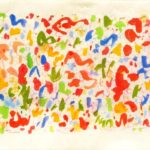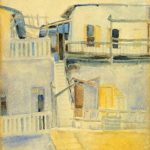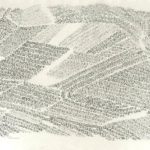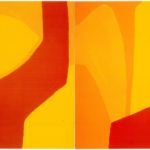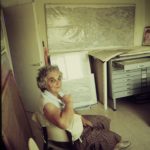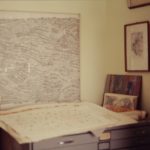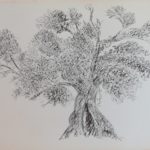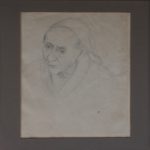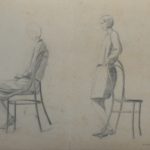Two themes dominate the art of Batia Grossbard and provide an insight into her creative process and aims.
These themes emerged in the 1960’s as, at last, time and space allowed creativity to flourish.
These notes are based on many comments and explanations by Batia Grossbard over many years.
But first, some notes, on the conflict most artists confront between their creative desires and needs and the reality of everyday life, such as family, earning an income, circumstances, and in Batia’s case also the effects of world history on her life. Leaving everything behind and starting again – a new country and a world war and the holocaust that upended life for everyone.
Batia showed a talent for drawing early in life. Born to a large family where education was encouraged and supported. She was the youngest of eleven children. Her abilities were recognized and she was sent to study at the Academy of Art in Warsaw, Poland where she received classical training, as academies did then. Figure drawing, architectural drawings, plaster casts, etc. were the training dominant. Precision, representation, shadowing, perspective, composition are the qualities that were taught. Modern art influences such as Impressionism and Abstract Art were not part of the curriculum. She was an exceptional student, as the examples show.
But then life took a different turn, there was not much time for art. In 1938 (aged just 28) she left Poland for Palestine (now Israel) as a tourist, at the encouragement of her eldest brother (who brought his family one by one) and overstayed her visa as the situation in Europe deteriorated. She had no place to practice art and no money for art materials. Then came the Second World War, and Batia volunteered to serve in the British Army in the Western Desert (Egypt), only returning to Haifa in 1945 to establish life with her partner, Yehoshua Grossbard, whom she met as an 18 years old, in Poland, himself an artist.
Life was hard and poor. Hoping for a better future, two children were born – a daughter and a son. Living for years, five people in a one room flat. Finally joining the Education Department as an art teacher at elementary schools – a profession she practiced until her retirement. It is impossible to create art under these circumstances. There was no room, no money and no energy after work and domestic duties were fulfilled. Batia was also deeply involved in Left politics in the 1950’s.
A move to a larger flat in the mid 1950’s, the children at school and facilities becoming available (including in the artists’ village of Ein Hod, established in 1953) which had Lithography workshop and she and Yehoshua owned a small house to work in, she was finally able to become creative. By that time she is in her 40’s.
A major break came in the 1950’s when she could afford to go to Paris, France to study, under the famed artist Andre Lhote, It was a turning point. She came back energized and enthused.
Modernism and abstract art obviously influenced her as they did many others. Representative art almost disappeared for a while. The rejection of representation, freedom of color and interaction with other artists were a catalyst for an intense period of work. She was catching up on lost decades.
With the children grown, more space and endless energy, Batia’s creativity intensified with the passage of time, producing more and more on larger and larger scale, in watercolor rolls measuring some 6 metres long and a metre high, sheets glued together, working on the floor with energetic hand movement, creating vast tapestries of intense color and movement.
On the other hand, large oil paintings worked carefully with palette knife to produce very smooth surfaces in subtle tonality variations in Cadmium Orange, insisting on Winsor and Newton brand for its excellent quality.
THE BRUSH STROKE AS ARTIST PERSONAL SIGNATURE:
Every painting or drawing is made up of strokes of paint or marks of graphics. That is a fact. The artist takes the foundation (canvas or paper) and applies paint or graphic marks over it, is what creates a work of art. The change over the last two centuries from seamless techniques where the individual brushstrokes are invisible, with the purpose of creating a representative image of reality outside the work of art, to the creation of image effects by individual brush or palette strokes is what defined progress in art techniques.
From the 1960’s Batia Grossbard developed a personal language of marking the surface with “squiggles” a continuous pencil or charcoal line that slowly built the surface to the desired image. She continued this exploration of the graphic mark in Lithography, watercolours and oils. Nothing was small, everything was large and exuberant, yet delicate in the extreme. The marking of the surface with such energy is both a physical act and an outpouring of emotional energy, via the hand movement. The physical stroke of the brush becomes a personal signature, identifying the artist, what matters is the energy, the power of application, that is what, for Batia, created the work of art.
Later in life, in her sixties, Batia painted massive oil canvasses where the individual stroke has been magnified as if seen through a microscope. Paintings, nearly 2 metres tall, almost monochromatic, usually in Winsor and Newton’s Cadmium Red or Cadmium Orange, the most difficult and expensive oil paint, which she turned into delicate, joyful, smooth surfaces. She is examining in her work the most elementary component of an art work – the individual stroke. Each color on the canvas is smoothed to perfection, so that only the shape of the mark matters.
HAND MOVEMENT AS MESSANGER OF PERSONALITY:
There seems to be contradiction between painting with great energy and delicacy, but that is what Batia Grossbard tried to express through her technique. Her personality was of attention to detail, thoughtfulness and sensitivity to the outside world. Not having other outlets, a person of few words, she used her art to express those internal feelings and attitudes via intense absorption in pouring out her feelings on canvas and paper with greater and greater verve and daring. At an age when other artists change little in their style, she broke new grounds of form and style, only to be stopped by her failing body.
